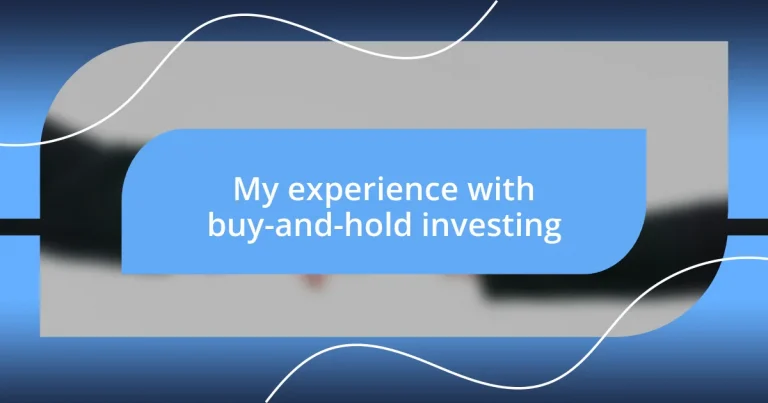Key takeaways:
- Buy-and-hold investing emphasizes patience and emotional resilience, transforming anxiety into long-term growth by embracing market volatility.
- Key principles include thorough research, maintaining realistic expectations, and diversifying investments to mitigate risk.
- Establishing a disciplined review routine and understanding one’s investment horizon are crucial for staying committed to long-term financial goals.

Understanding buy-and-hold investing
Buy-and-hold investing is fundamentally about patience and trust in the market’s long-term potential. I remember when I first dived into this strategy; it felt almost counterintuitive to sit back while my investments fluctuated. It’s a bit like watching a pot boil—you know it’s going to happen, but every moment feels excruciatingly slow.
One of the most powerful insights I gained was understanding that buy-and-hold isn’t just about picking great stocks; it’s about embracing volatility. I often found myself grappling with anxiety when the market dipped. Why do we fear market downturns so much? I realized that staying the course is where the real magic happens, allowing time for compounding to work in my favor.
Moreover, buy-and-hold investing requires a mindset shift. I’ve met investors whose emotional responses to market news led them to panic sell, missing out on substantial long-term gains. Isn’t it fascinating how our emotions can sabotage our financial strategies? In my case, learning to detach my self-worth from daily market movements made all the difference in sticking to my investment plan.

My journey into buy-and-hold
My journey into buy-and-hold investing began quite unexpectedly. I still vividly remember my first significant purchase—shares in a tech company I believed in. The excitement of hitting that “buy” button was thrilling, almost like a rite of passage. Yet, as the weeks turned into months, watching my investment experience both rises and falls taught me the true essence of this approach. Staying calm while my portfolio dipped required an emotional fortitude I wasn’t sure I possessed.
It was during one of those market downturns—when the numbers flashed red—that I had a real awakening. I remember calling a friend who was also an investor, seeking reassurance. “Is this normal?” I asked anxiously. He laughed. “If it wasn’t normal, would we be in this game?” That moment shifted my perspective; it made me realize that these fluctuations are part of the process. Adopting the buy-and-hold strategy meant embracing the journey, not just the outcome.
My realization was that patience and faith transform anxiety into resilience. I’ve learned to create a mental checklist for myself whenever doubt creeps in. This has turned the buy-and-hold strategy into much more than just an investment method; it became a personal growth journey. The freedom from constantly checking the market not only eased my stress but empowered me to focus on other life aspects while my investments did their thing.
| Key Aspect | My Experience |
|---|---|
| Initial Excitement | Adrenaline rush of buying shares |
| Emotional Challenges | Struggled with market dips |
| Support System | Friends provided perspective during downturns |

Key principles of buy-and-hold
The key principles of buy-and-hold investing revolve around a few foundational concepts that I’ve learned through experience. First, it’s important to recognize that understanding the value of what you invest in is crucial. For me, analyzing a company’s fundamentals—like its management, financial health, and industry position—has provided a solid base for confidence during market fluctuations. Along the way, I also discovered that having realistic expectations about investment returns helps maintain focus, especially during rough patches.
- Patience: Allow your investments the time to grow without the stress of daily fluctuations.
- Research: Know what you’re investing in and why; solid fundamentals offer peace of mind.
- Emotional resilience: Develop coping strategies to manage anxiety during market dips.
- Long-term vision: Concentrate on the bigger picture rather than short-term volatility.
- Diversification: Spread investments across sectors to mitigate risk effectively.
Having a plan and sticking to it becomes incredibly rewarding over time. I recall vividly the last major downturn I encountered; rather than selling off my stocks in panic, I logged into my portfolio and was surprised to see the long-term growth that had occurred despite temporary declines. This experience solidified my belief: adhering to buy-and-hold investing isn’t just about the numbers; it’s a commitment to a strategy that fosters not only financial growth but personal growth as well.

Benefits of long-term investing
Long-term investing offers remarkable benefits that can truly enhance an investor’s financial journey. One of my favorite aspects is the power of compounding, where your investment earns returns not just on the initial amount but also on any prior earnings. I still remember the surprise I felt when I calculated the growth of my earlier investments; seeing those figures grow year after year really brought the concept to life for me. It’s like planting a seed and watching it flourish into a tree, gradually providing shade—only in this case, it’s financial security over time.
Another significant advantage of this approach is reduced stress. When you step back and focus on longer time horizons, those day-to-day market fluctuations lose their grip on your peace of mind. I recall a moment of panic after reading about a sudden market dip, followed by a calm realization that my investment strategy wasn’t built for short bursts of activity. Instead, I had invested in solid companies with strong fundamentals. It was liberating to let go of the immediate stress and trust the market cycle.
Moreover, holding on to investments invites deeper knowledge and engagement with the companies I’ve chosen. Over time, I’ve developed a connection with my investments, understanding their growth stories and challenges. This experience has transformed investing from a mere financial transaction into a personal narrative that I actively participate in. Have you ever felt that way about an investment? That sense of ownership and commitment really adds value beyond just financial metrics—it’s about being part of something larger.

Common mistakes to avoid
When diving into buy-and-hold investing, one common mistake I’ve encountered is the tendency to act on fear during market downturns. I remember a time when I nearly sold a stock I believed in just because I panicked after a negative news headline. The urge to react can be powerful, but yielding to those emotions often leads to regrettable decisions. Instead, taking a breath and reminding myself of the company’s long-term prospects helped me stick to my strategy.
Another pitfall is neglecting to periodically review your portfolio. I’ve had experiences where I got too comfortable with my holdings and missed identifying underperformers. Holding onto a stock merely because it was “once a great investment” is risky. In my case, recognizing when to pivot or to cut losses has been an essential part of staying true to my long-term objectives.
Lastly, some investors mistakenly over-concentrate their holdings in a few stocks, thinking it will pay off big time. I know the thrill of riding high with a few favorites, but it’s easy to forget that diversification is crucial. I once had a significant portion of my portfolio tied up in a single company during a turbulent time; when that stock stumbled, I felt the repercussions sharply. Balancing my investments across different sectors allowed me to weather the storm much better than I would have otherwise. Have you considered how spreading your investments can safeguard your overall strategy?

Analyzing my investment decisions
As I reflect on my investment decisions, a key moment stands out: the realization that not every decision needs to be perfect. Early in my journey, I fixated on trying to predict market movements, only to find myself overwhelmed and often wrong. I’ve learned that it’s more about trusting the process and staying true to my strategy, rather than chasing after every new trend or noise in the market. Have you ever felt that pressure to always be “in the know”?
In another instance, I remember selling a stock too soon because it dipped slightly. I was caught up in the moment, especially after seeing my gains diminish. However, upon re-evaluation, I realized that the company’s fundamentals hadn’t changed. This taught me an invaluable lesson about patience—sometimes, it’s crucial to step back and assess the bigger picture rather than reacting impulsively to short-term movements. Have you experienced a similar situation, where holding on a bit longer could have led to better outcomes?
Lastly, I’ve come to appreciate the importance of setting clear criteria for my investments. Early on, my decisions felt somewhat arbitrary, often influenced by trends rather than substantial metrics. I developed a checklist that included factors like management quality and growth potential, which led to more confident choices. It’s amazing how defining your investment standards can transform the way you approach buying and holding. Have you defined what matters most to you when making investment decisions?

Tips for successful buy-and-hold strategy
One of the most significant tips I’ve found useful in my buy-and-hold strategy is to maintain a disciplined investing schedule. I remember setting aside specific times each month to review my portfolio instead of procrastinating or letting life distractions take over. This ritual helped me stay committed and aware of my investments, almost like visiting a good friend. Have you established a routine that keeps you connected to your financial goals?
Another valuable insight is having a clear understanding of your investment horizon. When I first started, I often worried about daily market fluctuations, which was exhausting. Then, I reminded myself that buy-and-hold investing is about the long game. I focused on my five- or ten-year plans instead of fretting over weekly reports. This shift in mindset allowed me to enjoy my life outside of investing, knowing my investments would weather short-term volatility. What would change if you looked beyond the daily noise?
Finally, it’s crucial to maintain an emotional buffer against the market’s ups and downs. I vividly recall a time when my portfolio soared during a bull market. The exhilaration was almost intoxicating, but I later learned that such high emotions can cloud judgment. Balancing my thrill with a healthy dose of skepticism helped me resist the temptation to chase after every hype. I now remind myself to keep emotions in check and focus on rational decisions. How do you keep your emotions in balance when market shifts occur?














